
What’s Included: Research Paper Template
If you’re preparing to write an academic research paper, our free research paper template is the perfect starting point. In the template, we cover every section step by step, with clear, straightforward explanations and examples .
The template’s structure is based on the tried and trusted best-practice format for formal academic research papers. The template structure reflects the overall research process, ensuring your paper will have a smooth, logical flow from chapter to chapter.
The research paper template covers the following core sections:
- The title page/cover page
- Abstract (sometimes also called the executive summary)
- Section 1: Introduction
- Section 2: Literature review
- Section 3: Methodology
- Section 4: Findings /results
- Section 5: Discussion
- Section 6: Conclusion
- Reference list
Each section is explained in plain, straightforward language , followed by an overview of the key elements that you need to cover within each section. We’ve also included links to free resources to help you understand how to write each section.
The cleanly formatted Google Doc can be downloaded as a fully editable MS Word Document (DOCX format), so you can use it as-is or convert it to LaTeX.
FAQs: Research Paper Template
What format is the template (doc, pdf, ppt, etc.).
The research paper template is provided as a Google Doc. You can download it in MS Word format or make a copy to your Google Drive. You’re also welcome to convert it to whatever format works best for you, such as LaTeX or PDF.
What types of research papers can this template be used for?
The template follows the standard best-practice structure for formal academic research papers, so it is suitable for the vast majority of degrees, particularly those within the sciences.
Some universities may have some additional requirements, but these are typically minor, with the core structure remaining the same. Therefore, it’s always a good idea to double-check your university’s requirements before you finalise your structure.
Is this template for an undergrad, Masters or PhD-level research paper?
This template can be used for a research paper at any level of study. It may be slight overkill for an undergraduate-level study, but it certainly won’t be missing anything.
How long should my research paper be?
This depends entirely on your university’s specific requirements, so it’s best to check with them. We include generic word count ranges for each section within the template, but these are purely indicative.
What about the research proposal?
If you’re still working on your research proposal, we’ve got a template for that here .
We’ve also got loads of proposal-related guides and videos over on the Grad Coach blog .
How do I write a literature review?
We have a wealth of free resources on the Grad Coach Blog that unpack how to write a literature review from scratch. You can check out the literature review section of the blog here.
How do I create a research methodology?
We have a wealth of free resources on the Grad Coach Blog that unpack research methodology, both qualitative and quantitative. You can check out the methodology section of the blog here.
Can I share this research paper template with my friends/colleagues?
Yes, you’re welcome to share this template. If you want to post about it on your blog or social media, all we ask is that you reference this page as your source.
Can Grad Coach help me with my research paper?
Within the template, you’ll find plain-language explanations of each section, which should give you a fair amount of guidance. However, you’re also welcome to consider our private coaching services .


APA Formatting and Style (7th ed.) for Student Papers
- What's New in the 7th ed.?
- Principles of Plagiarism: An Overview
- Basic Paper Formatting
- Basic Paper Elements
- Punctuation, Capitalization, Abbreviations, Apostrophes, Numbers, Plurals
- Tables and Figures
- Powerpoint Presentations
- Reference Page Format
- Periodicals (Journals, Magazines, Newspapers)
- Books and Reference Works
- Webpage on a Website
- Discussion Post
- Company Information & SWOT Analyses
- Dissertations or Theses
- ChatGPT and other AI Large Language Models
- Online Images
- Online Video
- Computer Software and Mobile Apps
- Missing Information
- Two Authors
- Three or More Authors
- Group Authors
- Missing Author
- Chat GPT and other AI Large Language Models
- Secondary Sources
- Block Quotations
- Fillable Template and Sample Paper
- Government Documents and Legal Materials
- APA Style 7th ed. Tutorials
- Additional APA 7th Resources
- Grammarly - your writing assistant
- Writing Center - Writing Skills This link opens in a new window
- Brainfuse Online Tutoring
APA 7th ed. Fillable Word Template and Sample Paper
- APA 7th ed. Template Download this Word document, fill out the title page and get writing!
- Sample Paper APA 7th ed. Our APA sample paper shows you how to format the main parts of a basic research paper.
- APA 7th Sample Papers from Purdue Owl
- << Previous: Block Quotations
- Next: Government Documents and Legal Materials >>
- Last Updated: May 3, 2024 2:22 PM
- URL: https://national.libguides.com/apa_7th

Use an APA or MLA template to start a paper online
It's quick and easy to get started on a paper like this while you're online.

Choose an APA template or MLA template , or other college-related template and open it in Word for the web to make it yours.
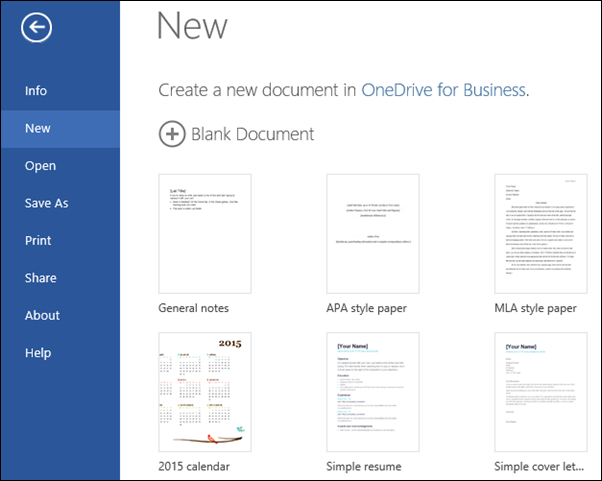
As you work on the paper, you'll probably want to rename it and edit the header with a running head of your own. When you cite sources, you'll want to add footnotes , and then compile your list of references (bibliography). Be sure also to include a table of contents that can update automatically. That way, you won't have to re-type page numbers every time you make changes that affect page breaks.
Work with others on your paper
If you're working with others, or even if you just want some feedback, you can easily share a link to the paper. People with the link can leave comments for you in the document.
When more than one person is editing in Word for the web, everyone will see each other's updates in the document. For more about how this works, see Work together on a document in Word for the web .
Turn in a hard-copy version
When you're finished, print out your paper to turn it in. You can do this with the paper still open in Word for the web. No need to save it first (that's already done for you).
To print, press Ctrl+P, and wait for the Print dialog.
Note: If you don't see a Print dialog box, click the link for opening a PDF version of your paper. From there, use the PDF program's Print command.

Need more help?
Want more options.
Explore subscription benefits, browse training courses, learn how to secure your device, and more.

Microsoft 365 subscription benefits

Microsoft 365 training

Microsoft security

Accessibility center
Communities help you ask and answer questions, give feedback, and hear from experts with rich knowledge.

Ask the Microsoft Community

Microsoft Tech Community

Windows Insiders
Microsoft 365 Insiders
Was this information helpful?
Thank you for your feedback.

- Master Your Homework
- Do My Homework
Formatting Research Papers in Word: A Guide
This article provides a comprehensive guide to formatting research papers in Microsoft Word. It outlines the various steps required for properly setting up documents, adding relevant text and references, as well as general principles of organizing and styling content for maximum impact. The guide will be invaluable for researchers looking to produce publications with an attractive visual layout without sacrificing readability or ease-of-use.
I. Introduction to Formatting Research Papers in Word
Ii. setting up a document template for research paper writing, iii. creating sections and adding text elements within the template.
- IV. Utilizing Tables, Equations, References & Citations
V. Using Word’s Language & Proofreading Tools for Quality Assurance
Vi. inserting visuals and graphics into the final draft of a paper, vii. optimizing file formats for digital delivery.
Formatting research papers in Microsoft Word can be a daunting task. Luckily, many of the necessary steps are intuitive and easy to learn. With just a few clicks of the mouse, you can easily achieve professionally-looking results without any fancy formatting knowledge or experience!
Begin by opening your document in MS Word. First off, create an unnumbered list for each element of your paper: Introduction, Methodology, Results/Analysis/Discussion (as applicable), Conclusion. Next up is setting page margins – these should all be set to 1 inch on all sides. It’s also important that single spacing is enabled; don’t forget this step as it helps keep everything consistent throughout the paper.
Now let’s turn our attention to font size and typeface selection – 10 point Times New Roman is preferred here for readability purposes. Additionally use bold styling where appropriate such as for headings within sections like subheadings too.
Finally when saving your file make sure you select .docx format so that others will have no issues downloading or editing your work if needed – luckily both Macs and PCs support this now universally accepted standard in word processing programs.
Creating a Template
Writing research papers can be daunting tasks, especially when it comes to ensuring they adhere to the correct format. Fortunately, creating a template document can make this process much easier. To start setting up your research paper template:
- Open up an empty word processor document.
- Choose “Format” from the toolbar and select “Page Setup”.
You may now specify all desired parameters of your page size (A4 or Letter-sized) margins, gutter settings and line spacing as well as orientation (portrait/landscape). This will set up the basic layout for your research paper in accordance with accepted standards.
Next you should establish any necessary headers/footers which include information such as title of work, student name and date submitted etc. Many universities have their own guidelines on what is required here so it’s important that these are followed carefully. Once again use Format menu options to customize these components before saving them into templates for future reuse.
“A little bit of preparation goes a long way.”
Formatting with HTML For those looking to add text elements into the template of their research paper, one should be aware that formatting is largely accomplished through the use of HTML. By understanding how to properly utilize hypertext markup language, a researcher can effectively customize different sections and aspects within their report. An example could include using italics for emphasis or unnumbered lists to break up content and help it flow more naturally.
When constructing headers and subheaders for specific sections in a document, this same principle applies. A user can simply insert these kinds of elements as they go along by adding tags such as “
Organizing Data Tables, equations and citations are essential elements of a research paper. Tables help to organize data and make it easy for readers to digest the information presented in an orderly fashion. Equations provide mathematical support for your arguments while properly referencing other sources lends authority to your work. The following provides a guide on how to utilize tables, equations, references and citations correctly within the format of a research paper.
- When using tables or figures in a research paper they should be numbered consecutively with Arabic numerals.
- Equations must also be numbered sequentially throughout the text with numbers enclosed in parentheses on the right margin.
. When citing another source within one’s own writing it is important that proper credit is given by including both an inline citation as well as providing detailed bibliographic reference at the end of document according either MLA or APA formatting guidelines (depending upon which style has been requested). Finally when quoting directly from outside sources always use quotation marks and include page numbers where appropriate.
Word’s Language & Proofreading Tools are an important resource for ensuring quality assurance in any academic paper.
- Language Tool
- Proofreading Tool
Overall, these tools allow writers of all levels to ensure quality assurance when writing papers at any level – whether it be undergraduate coursework or more advanced research publications
Including visuals and graphics into the final draft of a paper is an essential step in delivering engaging research findings. The inclusion of relevant images not only adds visual interest, but can often help to further explain complex ideas more effectively than words alone.
- Create visuals that are crisp, clear and concise. Choose simple yet eye-catching design elements such as colors, fonts and shapes.
- Ensure all figures used follow standard academic formatting guidelines . These may include specifications regarding figure titles or captions depending on your particular field or school requirements.
In the digital age, optimal file formats are essential for ensuring reliable delivery of content. To ensure this, there are several strategies that can be employed to guarantee efficient digital transfer and accurate representation of the material being sent.
- Compression: Compressing data into a smaller size will help maximize bandwidth and reduce transmission time. Common methods such as ZIP files or JPG images are useful options for compressing large media elements.
Using a standardized format is also important in order to maintain accuracy throughout all stages of the process; PDFs are often used as they retain formatting regardless of platform compatibility issues. In addition, using modern compression algorithms like JPEG 2000 ensures better quality when compressed while still providing minimal space requirements.
English: It is our sincere hope that this guide to formatting research papers in Word has proven a helpful and informative resource. We trust that readers of all levels have now gleaned important insights into the processes required for effectively utilizing Microsoft Word for their document preparation needs. As always, it is essential to adhere to accepted standards and conventions when preparing scholarly materials; however, with careful thoughtfulness and attentive consideration, we are confident that research paper authors can achieve an appropriately professional presentation of their work.

APA Style (7th ed.)
- Cite: Why? When?
- Book, eBook, Dissertation
- Article or Report
- Business Sources
- Artificial Intelligence (AI) Tools
- In-Text Citation
- Format Your Paper
Format Your Paper
Download and use the editable templates for student papers below: .
- APA 7th ed. Template Document This is an APA format template document in Google Docs. Click on the link -- it will ask for you to make a new copy of the document, which you can save in your own Google Drive with your preferred privacy settings.
- APA 7th ed. Template Document A Microsoft Word document formatted correctly according to APA 7th edition.
- APA 7th ed. Annotated Bibliography template A Microsoft Word document formatted correctly for an annotated bibliography.
Or, view the directions for specific sections below:
Order of sections (section 2.17).
- Title page including Title, Author, University and Department, Class, Instructor, and Date
- Body (including introduction, literature review or background, discussion, and conclusion)
- Appendices (including tables & figures)
Margins & Page Numbers (sections 2.22-2.24)
- 1 inch at top, bottom, and both sides
- Left aligned paragraphs and leave the right edge ragged (not "right justified")
- Indent first line of each paragraph 1/2 inch from left margin
- Use page numbers, including on the title page, 1/2 inch from top and flush with right margin
Text Format (section 2.19)
- Times New Roman, 12 point
- Calibri, 11 point
- Arial, 11 point
- Lucinda Sans Unicode, 10 point
- Georgia, 11 point
- Double-space and align text to the left
- Use active voice
- Don't overuse technical jargon
- No periods after a web address or DOI in the References list.
Tables and Figures In-Text (chapter 7)
- Label tables and figures numerically (ex. Table 1)
- Give each table column a heading and use separating lines only when necessary
- Design the table and figure so that it can be understood on its own, i.e. it does not require reference to the surrounding text to understand it
- Notes go below tables and figures
Title Page (section 2.3)
- Include the title, your name, the class name , and the college's name
- Title should be 12 words or less and summarize the paper's main idea
- No periods or abbreviations
- Do not italicize or underline
- No quotation marks, all capital letters, or bold
- Center horizontally in upper half of the page
Body (section 2.11)
- Align the text to the left with a 1/2-inch left indent on the first line
- Double-space
- As long as there is no Abstract, at the top of the first page, type the title of the paper, centered, in bold , and in Sentence Case Capitalization
- Usually, include sections like these: introduction, literature review or background, discussion, and conclusion -- but the specific organization will depend on the paper type
- Spell out long organization names and add the abbreviation in parenthesis, then just use the abbreviation
- Spell out numbers one through nine and use a number for 10 or more
- Use a number for units of measurement, in tables, to represent statistical or math functions, and dates or times
Headings (section 2.26-2.27)
- Level 1: Center, bold , Title Case
- Level 2: Align left, bold , Title Case
- Level 3: Alight left, bold italics , Title Case
- Level 4: Indented 1/2", bold , Title Case, end with a period. Follow with text.
- Level 5: Indented 1/2", bold italics , Title Case, end with a period. Follow with text.

Quotations (sections 8.26-8.33)
- Include short quotations (40 words or less) in-text with quotation marks
- For quotes more than 40 words, indent the entire quote a half inch from the left margin and double-space it with no quotation marks
- When quoting two or more paragraphs from an original source, indent the first line of each paragraph a half inch from the left margin
- Use ellipsis (...) when omitting sections from a quote and use four periods (....) if omitting the end section of a quote
References (section 2.12)
Begins on a new page following the text of your paper and includes complete citations for the resources you've used in your writing.
- References should be centered and bolded at the top of a new page
- Double-space and use hanging indents (where the first line is on the left margin and the following lines are indented a half inch from the left)
- List authors' last name first followed by the first and middle initials (ex. Skinner, B. F.)
- Alphabetize the list by the first author's last name of of each citation (see sections 9.44-9.49)
- Capitalize only the first word, the first after a colon or em dash, and proper nouns
- Don't capitalize the second word of a hyphenated compound
- No quotation marks around titles of articles
Appendices with Tables, Figures, & Illustrations (section 2.14, and chapter 7)
- Include appendices only to help the reader understand, evaluate, or replicate the study or argument
- Put each appendix on a separate page and align left
- For text, do not indent the first paragraph, but do indent the rest
- If you have only one appendix, label it "Appendix"
- If you have two or more appendices, label them "Appendix A", "Appendix B" and so forth as they appear in the body of your paper
- Label tables and figures numerically (ex. Table 1, or Table B1 and Table B2 if Appendix B has two tables) and describe them within the text of the appendix
- Notes go below tables and figures (see samples on p. 210-226)
Annotated Bibliography
Double-space the entire bibliography. give each entry a hanging indent. in the following annotation, indent the entire paragraph a half inch from the left margin and give the first line of each paragraph a half inch indent. see the template document at the top of this page..
- Check with your professor for the length of the annotation and which elements you should evaluate.
These elements are optional, if your professor or field requires them, but they are not required for student papers:
Abstract (section 2.9).
- Abstract gets its own page
- Center "Abstract" heading and do not indent the first line of the text
- Summarize the main points and purpose of the paper in 150-250 words maximum
- Define abbreviations and acronyms used in the paper
Running Head (section 2.8 )
- Shorten title to 50 characters or less (counting spaces and punctuation) for the running head
- In the top margin, the running head is aligned left, with the page number aligned on the right
- On every page, put (without the brackets): [SHORTENED TITLE OF YOUR PAPER IN ALL CAPS] [page number]
More questions? Check out the authoritative source: APA style blog
- << Previous: In-Text Citation
- Last Updated: May 16, 2024 12:36 PM
- URL: https://libguides.uww.edu/apa
- [email protected] / [email protected]
- Create Account
- Join to Connect:
IJSRP Research Paper Format
Welcome to the IJSRP Journal's official page for Research Paper Formatting! To ensure a seamless submission process and adherence to our publication standards, we provide a comprehensive Research Paper Format Template in Microsoft Word.
Research papers must be drafted in double column standard paper format (.doc/.docx) . In case paper have technical equations and not possible to format in double column format, you can format in Single Column format. Download the IJSRP paper format (MS-Word) template and submit your research paper for review/final publishing.
In case it is not possible to send paper in word format, you can send research paper in PDF or LATEX format. Kindly mention in paper submission email that paper is in Latex format.
Download Research Paper Format Template:
To download the research paper format, right-click the above link and choose "Save Link As..." to save the sample document to your computer. Paper must be send in .doc/.docx or PDF/LATEX format only.
Research Paper Format Template:
User-friendly in microsoft word:.
By utilizing our Research Paper Format Template, you streamline the submission process, making it easier for both authors and reviewers. Consistent formatting promotes a polished appearance, demonstrating your commitment to scholarly excellence.
Ensuring Journal Standards:
We encourage all authors to download our Research Paper Format Template to enhance the presentation and organization of their research papers. For any further inquiries or assistance, please refer to the submission guidelines provided on our website or contact our editorial team.
- Privacy Policy

Home » Research Paper Format – Types, Examples and Templates
Research Paper Format – Types, Examples and Templates
Table of Contents

Research paper format is an essential aspect of academic writing that plays a crucial role in the communication of research findings . The format of a research paper depends on various factors such as the discipline, style guide, and purpose of the research. It includes guidelines for the structure, citation style, referencing , and other elements of the paper that contribute to its overall presentation and coherence. Adhering to the appropriate research paper format is vital for ensuring that the research is accurately and effectively communicated to the intended audience. In this era of information, it is essential to understand the different research paper formats and their guidelines to communicate research effectively, accurately, and with the required level of detail. This post aims to provide an overview of some of the common research paper formats used in academic writing.
Research Paper Formats
Research Paper Formats are as follows:
- APA (American Psychological Association) format
- MLA (Modern Language Association) format
- Chicago/Turabian style
- IEEE (Institute of Electrical and Electronics Engineers) format
- AMA (American Medical Association) style
- Harvard style
- Vancouver style
- ACS (American Chemical Society) style
- ASA (American Sociological Association) style
- APSA (American Political Science Association) style
APA (American Psychological Association) Format
Here is a general APA format for a research paper:
- Title Page: The title page should include the title of your paper, your name, and your institutional affiliation. It should also include a running head, which is a shortened version of the title, and a page number in the upper right-hand corner.
- Abstract : The abstract is a brief summary of your paper, typically 150-250 words. It should include the purpose of your research, the main findings, and any implications or conclusions that can be drawn.
- Introduction: The introduction should provide background information on your topic, state the purpose of your research, and present your research question or hypothesis. It should also include a brief literature review that discusses previous research on your topic.
- Methods: The methods section should describe the procedures you used to collect and analyze your data. It should include information on the participants, the materials and instruments used, and the statistical analyses performed.
- Results: The results section should present the findings of your research in a clear and concise manner. Use tables and figures to help illustrate your results.
- Discussion : The discussion section should interpret your results and relate them back to your research question or hypothesis. It should also discuss the implications of your findings and any limitations of your study.
- References : The references section should include a list of all sources cited in your paper. Follow APA formatting guidelines for your citations and references.
Some additional tips for formatting your APA research paper:
- Use 12-point Times New Roman font throughout the paper.
- Double-space all text, including the references.
- Use 1-inch margins on all sides of the page.
- Indent the first line of each paragraph by 0.5 inches.
- Use a hanging indent for the references (the first line should be flush with the left margin, and all subsequent lines should be indented).
- Number all pages, including the title page and references page, in the upper right-hand corner.
APA Research Paper Format Template
APA Research Paper Format Template is as follows:
Title Page:
- Title of the paper
- Author’s name
- Institutional affiliation
- A brief summary of the main points of the paper, including the research question, methods, findings, and conclusions. The abstract should be no more than 250 words.
Introduction:
- Background information on the topic of the research paper
- Research question or hypothesis
- Significance of the study
- Overview of the research methods and design
- Brief summary of the main findings
- Participants: description of the sample population, including the number of participants and their characteristics (age, gender, ethnicity, etc.)
- Materials: description of any materials used in the study (e.g., survey questions, experimental apparatus)
- Procedure: detailed description of the steps taken to conduct the study
- Presentation of the findings of the study, including statistical analyses if applicable
- Tables and figures may be included to illustrate the results
Discussion:
- Interpretation of the results in light of the research question and hypothesis
- Implications of the study for the field
- Limitations of the study
- Suggestions for future research
References:
- A list of all sources cited in the paper, in APA format
Formatting guidelines:
- Double-spaced
- 12-point font (Times New Roman or Arial)
- 1-inch margins on all sides
- Page numbers in the top right corner
- Headings and subheadings should be used to organize the paper
- The first line of each paragraph should be indented
- Quotations of 40 or more words should be set off in a block quote with no quotation marks
- In-text citations should include the author’s last name and year of publication (e.g., Smith, 2019)
APA Research Paper Format Example
APA Research Paper Format Example is as follows:
The Effects of Social Media on Mental Health
University of XYZ
This study examines the relationship between social media use and mental health among college students. Data was collected through a survey of 500 students at the University of XYZ. Results suggest that social media use is significantly related to symptoms of depression and anxiety, and that the negative effects of social media are greater among frequent users.
Social media has become an increasingly important aspect of modern life, especially among young adults. While social media can have many positive effects, such as connecting people across distances and sharing information, there is growing concern about its impact on mental health. This study aims to examine the relationship between social media use and mental health among college students.
Participants: Participants were 500 college students at the University of XYZ, recruited through online advertisements and flyers posted on campus. Participants ranged in age from 18 to 25, with a mean age of 20.5 years. The sample was 60% female, 40% male, and 5% identified as non-binary or gender non-conforming.
Data was collected through an online survey administered through Qualtrics. The survey consisted of several measures, including the Patient Health Questionnaire-9 (PHQ-9) for depression symptoms, the Generalized Anxiety Disorder-7 (GAD-7) for anxiety symptoms, and questions about social media use.
Procedure :
Participants were asked to complete the online survey at their convenience. The survey took approximately 20-30 minutes to complete. Data was analyzed using descriptive statistics, correlations, and multiple regression analysis.
Results indicated that social media use was significantly related to symptoms of depression (r = .32, p < .001) and anxiety (r = .29, p < .001). Regression analysis indicated that frequency of social media use was a significant predictor of both depression symptoms (β = .24, p < .001) and anxiety symptoms (β = .20, p < .001), even when controlling for age, gender, and other relevant factors.
The results of this study suggest that social media use is associated with symptoms of depression and anxiety among college students. The negative effects of social media are greater among frequent users. These findings have important implications for mental health professionals and educators, who should consider addressing the potential negative effects of social media use in their work with young adults.
References :
References should be listed in alphabetical order according to the author’s last name. For example:
- Chou, H. T. G., & Edge, N. (2012). “They are happier and having better lives than I am”: The impact of using Facebook on perceptions of others’ lives. Cyberpsychology, Behavior, and Social Networking, 15(2), 117-121.
- Twenge, J. M., Joiner, T. E., Rogers, M. L., & Martin, G. N. (2018). Increases in depressive symptoms, suicide-related outcomes, and suicide rates among U.S. adolescents after 2010 and links to increased new media screen time. Clinical Psychological Science, 6(1), 3-17.
Note: This is just a sample Example do not use this in your assignment.

MLA (Modern Language Association) Format
MLA (Modern Language Association) Format is as follows:
- Page Layout : Use 8.5 x 11-inch white paper, with 1-inch margins on all sides. The font should be 12-point Times New Roman or a similar serif font.
- Heading and Title : The first page of your research paper should include a heading and a title. The heading should include your name, your instructor’s name, the course title, and the date. The title should be centered and in title case (capitalizing the first letter of each important word).
- In-Text Citations : Use parenthetical citations to indicate the source of your information. The citation should include the author’s last name and the page number(s) of the source. For example: (Smith 23).
- Works Cited Page : At the end of your paper, include a Works Cited page that lists all the sources you used in your research. Each entry should include the author’s name, the title of the work, the publication information, and the medium of publication.
- Formatting Quotations : Use double quotation marks for short quotations and block quotations for longer quotations. Indent the entire quotation five spaces from the left margin.
- Formatting the Body : Use a clear and readable font and double-space your text throughout. The first line of each paragraph should be indented one-half inch from the left margin.
MLA Research Paper Template
MLA Research Paper Format Template is as follows:
- Use 8.5 x 11 inch white paper.
- Use a 12-point font, such as Times New Roman.
- Use double-spacing throughout the entire paper, including the title page and works cited page.
- Set the margins to 1 inch on all sides.
- Use page numbers in the upper right corner, beginning with the first page of text.
- Include a centered title for the research paper, using title case (capitalizing the first letter of each important word).
- Include your name, instructor’s name, course name, and date in the upper left corner, double-spaced.
In-Text Citations
- When quoting or paraphrasing information from sources, include an in-text citation within the text of your paper.
- Use the author’s last name and the page number in parentheses at the end of the sentence, before the punctuation mark.
- If the author’s name is mentioned in the sentence, only include the page number in parentheses.
Works Cited Page
- List all sources cited in alphabetical order by the author’s last name.
- Each entry should include the author’s name, title of the work, publication information, and medium of publication.
- Use italics for book and journal titles, and quotation marks for article and chapter titles.
- For online sources, include the date of access and the URL.
Here is an example of how the first page of a research paper in MLA format should look:
Headings and Subheadings
- Use headings and subheadings to organize your paper and make it easier to read.
- Use numerals to number your headings and subheadings (e.g. 1, 2, 3), and capitalize the first letter of each word.
- The main heading should be centered and in boldface type, while subheadings should be left-aligned and in italics.
- Use only one space after each period or punctuation mark.
- Use quotation marks to indicate direct quotes from a source.
- If the quote is more than four lines, format it as a block quote, indented one inch from the left margin and without quotation marks.
- Use ellipses (…) to indicate omitted words from a quote, and brackets ([…]) to indicate added words.
Works Cited Examples
- Book: Last Name, First Name. Title of Book. Publisher, Publication Year.
- Journal Article: Last Name, First Name. “Title of Article.” Title of Journal, volume number, issue number, publication date, page numbers.
- Website: Last Name, First Name. “Title of Webpage.” Title of Website, publication date, URL. Accessed date.
Here is an example of how a works cited entry for a book should look:
Smith, John. The Art of Writing Research Papers. Penguin, 2021.
MLA Research Paper Example
MLA Research Paper Format Example is as follows:
Your Professor’s Name
Course Name and Number
Date (in Day Month Year format)
Word Count (not including title page or Works Cited)
Title: The Impact of Video Games on Aggression Levels
Video games have become a popular form of entertainment among people of all ages. However, the impact of video games on aggression levels has been a subject of debate among scholars and researchers. While some argue that video games promote aggression and violent behavior, others argue that there is no clear link between video games and aggression levels. This research paper aims to explore the impact of video games on aggression levels among young adults.
Background:
The debate on the impact of video games on aggression levels has been ongoing for several years. According to the American Psychological Association, exposure to violent media, including video games, can increase aggression levels in children and adolescents. However, some researchers argue that there is no clear evidence to support this claim. Several studies have been conducted to examine the impact of video games on aggression levels, but the results have been mixed.
Methodology:
This research paper used a quantitative research approach to examine the impact of video games on aggression levels among young adults. A sample of 100 young adults between the ages of 18 and 25 was selected for the study. The participants were asked to complete a questionnaire that measured their aggression levels and their video game habits.
The results of the study showed that there was a significant correlation between video game habits and aggression levels among young adults. The participants who reported playing violent video games for more than 5 hours per week had higher aggression levels than those who played less than 5 hours per week. The study also found that male participants were more likely to play violent video games and had higher aggression levels than female participants.
The findings of this study support the claim that video games can increase aggression levels among young adults. However, it is important to note that the study only examined the impact of video games on aggression levels and did not take into account other factors that may contribute to aggressive behavior. It is also important to note that not all video games promote violence and aggression, and some games may have a positive impact on cognitive and social skills.
Conclusion :
In conclusion, this research paper provides evidence to support the claim that video games can increase aggression levels among young adults. However, it is important to conduct further research to examine the impact of video games on other aspects of behavior and to explore the potential benefits of video games. Parents and educators should be aware of the potential impact of video games on aggression levels and should encourage young adults to engage in a variety of activities that promote cognitive and social skills.
Works Cited:
- American Psychological Association. (2017). Violent Video Games: Myths, Facts, and Unanswered Questions. Retrieved from https://www.apa.org/news/press/releases/2017/08/violent-video-games
- Ferguson, C. J. (2015). Do Angry Birds make for angry children? A meta-analysis of video game influences on children’s and adolescents’ aggression, mental health, prosocial behavior, and academic performance. Perspectives on Psychological Science, 10(5), 646-666.
- Gentile, D. A., Swing, E. L., Lim, C. G., & Khoo, A. (2012). Video game playing, attention problems, and impulsiveness: Evidence of bidirectional causality. Psychology of Popular Media Culture, 1(1), 62-70.
- Greitemeyer, T. (2014). Effects of prosocial video games on prosocial behavior. Journal of Personality and Social Psychology, 106(4), 530-548.
Chicago/Turabian Style
Chicago/Turabian Formate is as follows:
- Margins : Use 1-inch margins on all sides of the paper.
- Font : Use a readable font such as Times New Roman or Arial, and use a 12-point font size.
- Page numbering : Number all pages in the upper right-hand corner, beginning with the first page of text. Use Arabic numerals.
- Title page: Include a title page with the title of the paper, your name, course title and number, instructor’s name, and the date. The title should be centered on the page and in title case (capitalize the first letter of each word).
- Headings: Use headings to organize your paper. The first level of headings should be centered and in boldface or italics. The second level of headings should be left-aligned and in boldface or italics. Use as many levels of headings as necessary to organize your paper.
- In-text citations : Use footnotes or endnotes to cite sources within the text of your paper. The first citation for each source should be a full citation, and subsequent citations can be shortened. Use superscript numbers to indicate footnotes or endnotes.
- Bibliography : Include a bibliography at the end of your paper, listing all sources cited in your paper. The bibliography should be in alphabetical order by the author’s last name, and each entry should include the author’s name, title of the work, publication information, and date of publication.
- Formatting of quotations: Use block quotations for quotations that are longer than four lines. Indent the entire quotation one inch from the left margin, and do not use quotation marks. Single-space the quotation, and double-space between paragraphs.
- Tables and figures: Use tables and figures to present data and illustrations. Number each table and figure sequentially, and provide a brief title for each. Place tables and figures as close as possible to the text that refers to them.
- Spelling and grammar : Use correct spelling and grammar throughout your paper. Proofread carefully for errors.
Chicago/Turabian Research Paper Template
Chicago/Turabian Research Paper Template is as folows:
Title of Paper
Name of Student
Professor’s Name
I. Introduction
A. Background Information
B. Research Question
C. Thesis Statement
II. Literature Review
A. Overview of Existing Literature
B. Analysis of Key Literature
C. Identification of Gaps in Literature
III. Methodology
A. Research Design
B. Data Collection
C. Data Analysis
IV. Results
A. Presentation of Findings
B. Analysis of Findings
C. Discussion of Implications
V. Conclusion
A. Summary of Findings
B. Implications for Future Research
C. Conclusion
VI. References
A. Bibliography
B. In-Text Citations
VII. Appendices (if necessary)
A. Data Tables
C. Additional Supporting Materials
Chicago/Turabian Research Paper Example
Title: The Impact of Social Media on Political Engagement
Name: John Smith
Class: POLS 101
Professor: Dr. Jane Doe
Date: April 8, 2023
I. Introduction:
Social media has become an integral part of our daily lives. People use social media platforms like Facebook, Twitter, and Instagram to connect with friends and family, share their opinions, and stay informed about current events. With the rise of social media, there has been a growing interest in understanding its impact on various aspects of society, including political engagement. In this paper, I will examine the relationship between social media use and political engagement, specifically focusing on how social media influences political participation and political attitudes.
II. Literature Review:
There is a growing body of literature on the impact of social media on political engagement. Some scholars argue that social media has a positive effect on political participation by providing new channels for political communication and mobilization (Delli Carpini & Keeter, 1996; Putnam, 2000). Others, however, suggest that social media can have a negative impact on political engagement by creating filter bubbles that reinforce existing beliefs and discourage political dialogue (Pariser, 2011; Sunstein, 2001).
III. Methodology:
To examine the relationship between social media use and political engagement, I conducted a survey of 500 college students. The survey included questions about social media use, political participation, and political attitudes. The data was analyzed using descriptive statistics and regression analysis.
Iv. Results:
The results of the survey indicate that social media use is positively associated with political participation. Specifically, respondents who reported using social media to discuss politics were more likely to have participated in a political campaign, attended a political rally, or contacted a political representative. Additionally, social media use was found to be associated with more positive attitudes towards political engagement, such as increased trust in government and belief in the effectiveness of political action.
V. Conclusion:
The findings of this study suggest that social media has a positive impact on political engagement, by providing new opportunities for political communication and mobilization. However, there is also a need for caution, as social media can also create filter bubbles that reinforce existing beliefs and discourage political dialogue. Future research should continue to explore the complex relationship between social media and political engagement, and develop strategies to harness the potential benefits of social media while mitigating its potential negative effects.
Vii. References:
- Delli Carpini, M. X., & Keeter, S. (1996). What Americans know about politics and why it matters. Yale University Press.
- Pariser, E. (2011). The filter bubble: What the Internet is hiding from you. Penguin.
- Putnam, R. D. (2000). Bowling alone: The collapse and revival of American community. Simon & Schuster.
- Sunstein, C. R. (2001). Republic.com. Princeton University Press.
IEEE (Institute of Electrical and Electronics Engineers) Format
IEEE (Institute of Electrical and Electronics Engineers) Research Paper Format is as follows:
- Title : A concise and informative title that accurately reflects the content of the paper.
- Abstract : A brief summary of the paper, typically no more than 250 words, that includes the purpose of the study, the methods used, the key findings, and the main conclusions.
- Introduction : An overview of the background, context, and motivation for the research, including a clear statement of the problem being addressed and the objectives of the study.
- Literature review: A critical analysis of the relevant research and scholarship on the topic, including a discussion of any gaps or limitations in the existing literature.
- Methodology : A detailed description of the methods used to collect and analyze data, including any experiments or simulations, data collection instruments or procedures, and statistical analyses.
- Results : A clear and concise presentation of the findings, including any relevant tables, graphs, or figures.
- Discussion : A detailed interpretation of the results, including a comparison of the findings with previous research, a discussion of the implications of the results, and any recommendations for future research.
- Conclusion : A summary of the key findings and main conclusions of the study.
- References : A list of all sources cited in the paper, formatted according to IEEE guidelines.
In addition to these elements, an IEEE research paper should also follow certain formatting guidelines, including using 12-point font, double-spaced text, and numbered headings and subheadings. Additionally, any tables, figures, or equations should be clearly labeled and referenced in the text.
AMA (American Medical Association) Style
AMA (American Medical Association) Style Research Paper Format:
- Title Page: This page includes the title of the paper, the author’s name, institutional affiliation, and any acknowledgments or disclaimers.
- Abstract: The abstract is a brief summary of the paper that outlines the purpose, methods, results, and conclusions of the study. It is typically limited to 250 words or less.
- Introduction: The introduction provides a background of the research problem, defines the research question, and outlines the objectives and hypotheses of the study.
- Methods: The methods section describes the research design, participants, procedures, and instruments used to collect and analyze data.
- Results: The results section presents the findings of the study in a clear and concise manner, using graphs, tables, and charts where appropriate.
- Discussion: The discussion section interprets the results, explains their significance, and relates them to previous research in the field.
- Conclusion: The conclusion summarizes the main points of the paper, discusses the implications of the findings, and suggests future research directions.
- References: The reference list includes all sources cited in the paper, listed in alphabetical order by author’s last name.
In addition to these sections, the AMA format requires that authors follow specific guidelines for citing sources in the text and formatting their references. The AMA style uses a superscript number system for in-text citations and provides specific formats for different types of sources, such as books, journal articles, and websites.
Harvard Style
Harvard Style Research Paper format is as follows:
- Title page: This should include the title of your paper, your name, the name of your institution, and the date of submission.
- Abstract : This is a brief summary of your paper, usually no more than 250 words. It should outline the main points of your research and highlight your findings.
- Introduction : This section should introduce your research topic, provide background information, and outline your research question or thesis statement.
- Literature review: This section should review the relevant literature on your topic, including previous research studies, academic articles, and other sources.
- Methodology : This section should describe the methods you used to conduct your research, including any data collection methods, research instruments, and sampling techniques.
- Results : This section should present your findings in a clear and concise manner, using tables, graphs, and other visual aids if necessary.
- Discussion : This section should interpret your findings and relate them to the broader research question or thesis statement. You should also discuss the implications of your research and suggest areas for future study.
- Conclusion : This section should summarize your main findings and provide a final statement on the significance of your research.
- References : This is a list of all the sources you cited in your paper, presented in alphabetical order by author name. Each citation should include the author’s name, the title of the source, the publication date, and other relevant information.
In addition to these sections, a Harvard Style research paper may also include a table of contents, appendices, and other supplementary materials as needed. It is important to follow the specific formatting guidelines provided by your instructor or academic institution when preparing your research paper in Harvard Style.
Vancouver Style
Vancouver Style Research Paper format is as follows:
The Vancouver citation style is commonly used in the biomedical sciences and is known for its use of numbered references. Here is a basic format for a research paper using the Vancouver citation style:
- Title page: Include the title of your paper, your name, the name of your institution, and the date.
- Abstract : This is a brief summary of your research paper, usually no more than 250 words.
- Introduction : Provide some background information on your topic and state the purpose of your research.
- Methods : Describe the methods you used to conduct your research, including the study design, data collection, and statistical analysis.
- Results : Present your findings in a clear and concise manner, using tables and figures as needed.
- Discussion : Interpret your results and explain their significance. Also, discuss any limitations of your study and suggest directions for future research.
- References : List all of the sources you cited in your paper in numerical order. Each reference should include the author’s name, the title of the article or book, the name of the journal or publisher, the year of publication, and the page numbers.
ACS (American Chemical Society) Style
ACS (American Chemical Society) Style Research Paper format is as follows:
The American Chemical Society (ACS) Style is a citation style commonly used in chemistry and related fields. When formatting a research paper in ACS Style, here are some guidelines to follow:
- Paper Size and Margins : Use standard 8.5″ x 11″ paper with 1-inch margins on all sides.
- Font: Use a 12-point serif font (such as Times New Roman) for the main text. The title should be in bold and a larger font size.
- Title Page : The title page should include the title of the paper, the authors’ names and affiliations, and the date of submission. The title should be centered on the page and written in bold font. The authors’ names should be centered below the title, followed by their affiliations and the date.
- Abstract : The abstract should be a brief summary of the paper, no more than 250 words. It should be on a separate page and include the title of the paper, the authors’ names and affiliations, and the text of the abstract.
- Main Text : The main text should be organized into sections with headings that clearly indicate the content of each section. The introduction should provide background information and state the research question or hypothesis. The methods section should describe the procedures used in the study. The results section should present the findings of the study, and the discussion section should interpret the results and provide conclusions.
- References: Use the ACS Style guide to format the references cited in the paper. In-text citations should be numbered sequentially throughout the text and listed in numerical order at the end of the paper.
- Figures and Tables: Figures and tables should be numbered sequentially and referenced in the text. Each should have a descriptive caption that explains its content. Figures should be submitted in a high-quality electronic format.
- Supporting Information: Additional information such as data, graphs, and videos may be included as supporting information. This should be included in a separate file and referenced in the main text.
- Acknowledgments : Acknowledge any funding sources or individuals who contributed to the research.
ASA (American Sociological Association) Style
ASA (American Sociological Association) Style Research Paper format is as follows:
- Title Page: The title page of an ASA style research paper should include the title of the paper, the author’s name, and the institutional affiliation. The title should be centered and should be in title case (the first letter of each major word should be capitalized).
- Abstract: An abstract is a brief summary of the paper that should appear on a separate page immediately following the title page. The abstract should be no more than 200 words in length and should summarize the main points of the paper.
- Main Body: The main body of the paper should begin on a new page following the abstract page. The paper should be double-spaced, with 1-inch margins on all sides, and should be written in 12-point Times New Roman font. The main body of the paper should include an introduction, a literature review, a methodology section, results, and a discussion.
- References : The reference section should appear on a separate page at the end of the paper. All sources cited in the paper should be listed in alphabetical order by the author’s last name. Each reference should include the author’s name, the title of the work, the publication information, and the date of publication.
- Appendices : Appendices are optional and should only be included if they contain information that is relevant to the study but too lengthy to be included in the main body of the paper. If you include appendices, each one should be labeled with a letter (e.g., Appendix A, Appendix B, etc.) and should be referenced in the main body of the paper.
APSA (American Political Science Association) Style
APSA (American Political Science Association) Style Research Paper format is as follows:
- Title Page: The title page should include the title of the paper, the author’s name, the name of the course or instructor, and the date.
- Abstract : An abstract is typically not required in APSA style papers, but if one is included, it should be brief and summarize the main points of the paper.
- Introduction : The introduction should provide an overview of the research topic, the research question, and the main argument or thesis of the paper.
- Literature Review : The literature review should summarize the existing research on the topic and provide a context for the research question.
- Methods : The methods section should describe the research methods used in the paper, including data collection and analysis.
- Results : The results section should present the findings of the research.
- Discussion : The discussion section should interpret the results and connect them back to the research question and argument.
- Conclusion : The conclusion should summarize the main findings and implications of the research.
- References : The reference list should include all sources cited in the paper, formatted according to APSA style guidelines.
In-text citations in APSA style use parenthetical citation, which includes the author’s last name, publication year, and page number(s) if applicable. For example, (Smith 2010, 25).
About the author
Muhammad Hassan
Researcher, Academic Writer, Web developer
You may also like

How to Cite Research Paper – All Formats and...

Delimitations in Research – Types, Examples and...

Research Design – Types, Methods and Examples

Research Paper Title – Writing Guide and Example

Research Paper Introduction – Writing Guide and...

Research Paper Conclusion – Writing Guide and...
Paper and report design and layout templates
Pen perfect looking papers and reports every time when you start your assignment with a customizable design and layout template. whether you want your paper to pop off the page or you need your report to represent your data in the best light, you'll find the right template for your next paper..

Perfect your papers and reports with customizable templates
Your papers and reports will look as professional and well put together as they sound when you compose them using customizable Word templates . Whether you're writing a research paper for your university course or putting together a high priority presentation , designer-created templates are here to help you get started. First impressions are important, even for papers, and layout can make or break someone's interest in your content. Don't risk it by freestyling, start with a tried-and-true template. Remember, though: Papers and reports don't have to be boring. Professional can still pop. Tweak your favorite layout template to match your unique aesthetic for a grade A package.

- Langson Library
- Science Library
- Grunigen Medical Library
- Law Library
- Connect From Off-Campus
- Accessibility
- Gateway Study Center

Email this link
Thesis / dissertation formatting manual (2024).
- Filing Fees and Student Status
- Submission Process Overview
- Electronic Thesis Submission
- Paper Thesis Submission
- Formatting Overview
- Fonts/Typeface
- Pagination, Margins, Spacing
- Paper Thesis Formatting
- Preliminary Pages Overview
- Copyright Page
- Dedication Page
- Table of Contents
- List of Figures (etc.)
- Acknowledgements
- Text and References Overview
- Figures and Illustrations
- Using Your Own Previously Published Materials
- Using Copyrighted Materials by Another Author
- Open Access and Embargoes
- Copyright and Creative Commons
- Ordering Print (Bound) Copies
- Tutorials and Assistance
- FAQ This link opens in a new window
UCI Libraries maintains the following templates to assist in formatting your graduate manuscript. If you are formatting your manuscript in Microsoft Word, feel free to download and use the template. If you would like to see what your manuscript should look like, PDFs have been provided. If you are formatting your manuscript using LaTex, UCI maintains a template on OverLeaf.
- Annotated Template (Dissertation) 2024 PDF of a template with annotations of what to look out for
- Word: Thesis Template 2024 Editable template of the Master's thesis formatting.
- PDF Thesis Template 2024
- Word: Dissertation Template 2024 Editable template of the PhD Dissertation formatting.
- PDF: Dissertation Template 2024
- Overleaf (LaTex) Template
- << Previous: Tutorials and Assistance
- Next: FAQ >>
- Last Updated: Feb 20, 2024 2:09 PM
- URL: https://guides.lib.uci.edu/gradmanual
Off-campus? Please use the Software VPN and choose the group UCIFull to access licensed content. For more information, please Click here
Software VPN is not available for guests, so they may not have access to some content when connecting from off-campus.
- SpringerLink shop
Research Template in Word
When It Comes to Preparing a Research Paper or Essay Outline, Knowing Various Writing Styles Like MLA Style and MLA Format Is Advantageous. Template.net Provides Project Reports, Proposals, and Outline Examples That You Can Use for Your Academic Papers. Visit Template.net for Various Documents for Your Convenience and Download These Templates Today!
- Research Agreement
- Research Analysis
- Research Associate
- Research Flowchart
- Research Letter
- Research Organizational Chart
- Research Paper
- Research Paper Essay
- Research Plan
- Research Poster
- Research Project
- Research Proposal
- Research Report
- Research Resume
- Research White Paper
- Researcher Resume
Make your research work successful and insightful by streamlining your research documentation and reporting procedures. Template.net is among the best platforms that offer premium research templates and samples in Word and other amazing formats.
Research generally refers to a systematic activity of studying a certain subject. There are several kinds of research and the methodologies vary with respect to each kind of undertaking. There are academic and scientific research work, market research for businesses and among others. Aside from these, research is divided into different types such as applied research, quantitative and qualitative research, and etc. The bottom line is that researchers must ace every step of the research process from the planning, proposal writing, gathering of data, and actual presentation of the research report or study to its target audience.
Considering the tedious and complex nature of the entire research process, it would surely give you a positive boost to have samples of research documents and templates to refer to. Template.net offers a wide array of research document samples to help you organize your research team, write your proposal, and complete the whole process without any hassle on your end. The contents of each templates are original and made by industry experts. They ensured that the essential sections of a particular research document are present in the samples such as the background of the study, the methodology, presentation of the results of the survey, and more. Furthermore, the designs are 100% printable. So, what are you waiting for? Download these templates now.
Get Instant Access to 50,000+ MS Word Templates
- Access to 1 Million+ Templates & Tools
- 500,000+ Microsoft 365 Templates including Excel, Powerpoint, Publisher, Outlook & PDF
- Unlimited access to Design & Documents AI editors
- Professionally Made Content and Beautifully Designed
- Instant Download & 100% Customizable
30 day money back guarantee
11 Best Word Report Template Sites (2024) [FREE]
1. introduction.
In today’s fast-paced business world, professionals are often tasked with creating detailed and appealing reports. These reports must be informative, easy to read, and visually pleasing. A well-designed report can make a significant impact on the readers, convincing them of the findings presented. This is where Word report template sites come into play.
1.1 Importance of Word Report Template Site
Word report template sites offer a variety of pre-designed report templates that can greatly reduce the time and effort involved in creating a report from scratch. These templates include different layouts, graphic elements, chart designs, and more. Whether it’s a business report, project report, or academic paper, these templates provide a professional look while maintaining the ease of customization. They are an invaluable tool for anyone tasked with creating a compelling report.
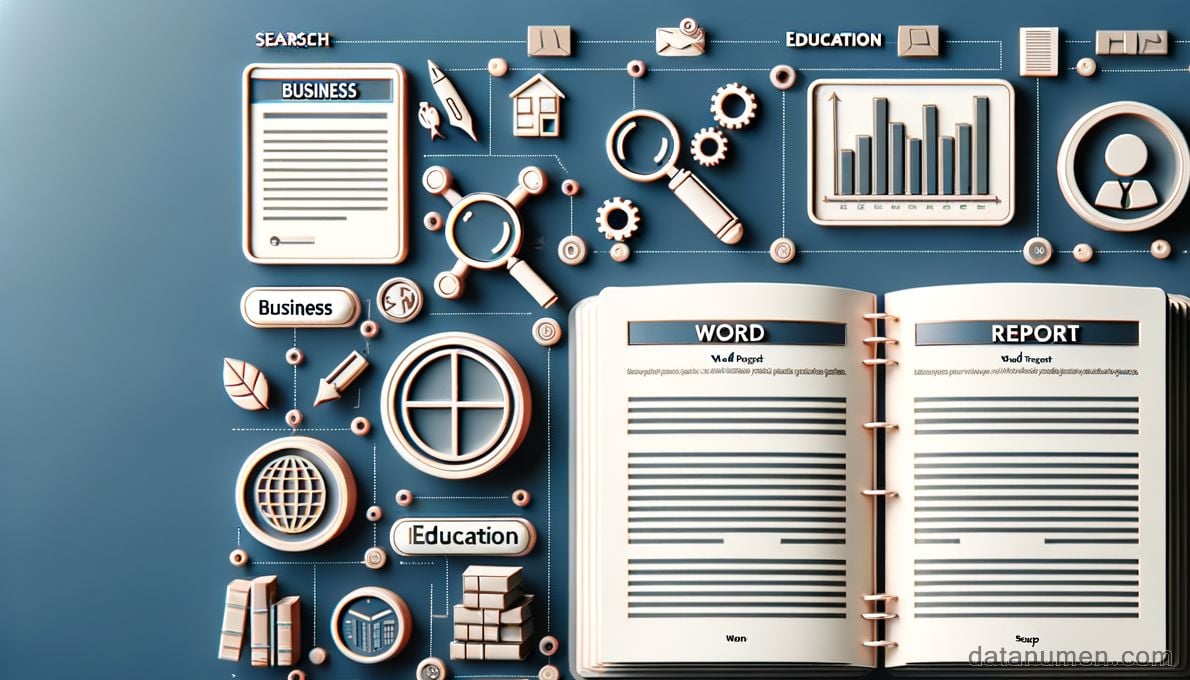
1.2 Objectives of this Comparison
The objective of this comparison is to guide users in choosing a suitable Word report template site according to their needs. Among the hundreds of template sites available, the choice can be overwhelming. Careful comparison, based on specific criteria such as the variety, aesthetic quality, ease of use, and cost of templates, will enable users to make an informed decision. Through this analysis, we will identify the pros and cons of each site, to assist you in finding a site that best meets your unique needs.
1.3 Word Document Repair Tool
A powerful Word document repair tool is also essential to all Word users. DataNumen Word Repair is a preferred one:
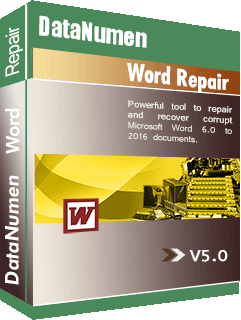
2. Microsoft Report Template
The Microsoft Office’s report template collection is the official resource for Word templates, offering a wide array of options for different types of reports. Whether you’re crafting an annual corporate report, a research report, a project status report, or a student report, Microsoft provides numerous templates to suit your needs.
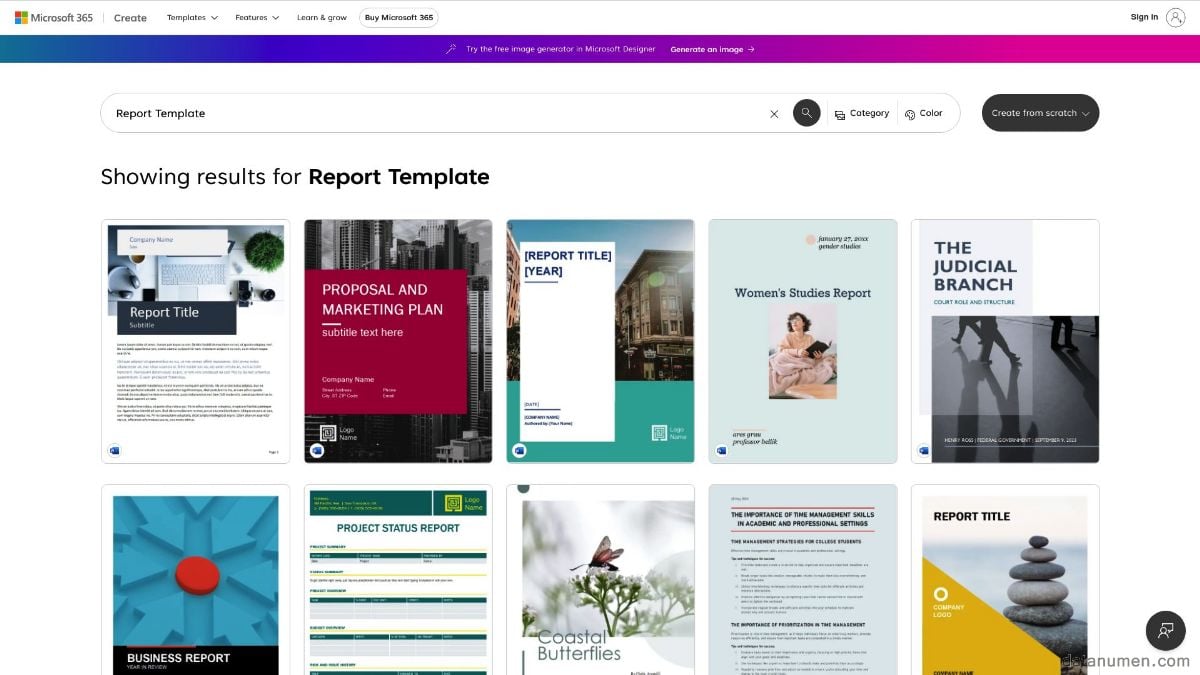
- Variety: There are hundreds of report templates available, suitable for different purposes, industries, and formats.
- Compatibility: Being a product of the same parent company, these templates are fully compatible with MS Word, ensuring that there won’t be any compatibility issues.
- Cost: All templates here are free of charge and can be downloaded directly from the site.
- Customization: Although the templates are extensive, they may lack the level of customization offered by some other websites.
- Unique Designs: Despite the sheer volume of templates, there is a possibility that other users may frequently use some of the more popular templates, reducing its uniqueness.
3. Template.Net Report Template In Word
Template.net offers a wide selection of report templates for Word with a distinctive focus on design-based templates. The platform serves as a marketplace for creative professionals to share their work, covering diverse fields such as business, education, marketing, and more.
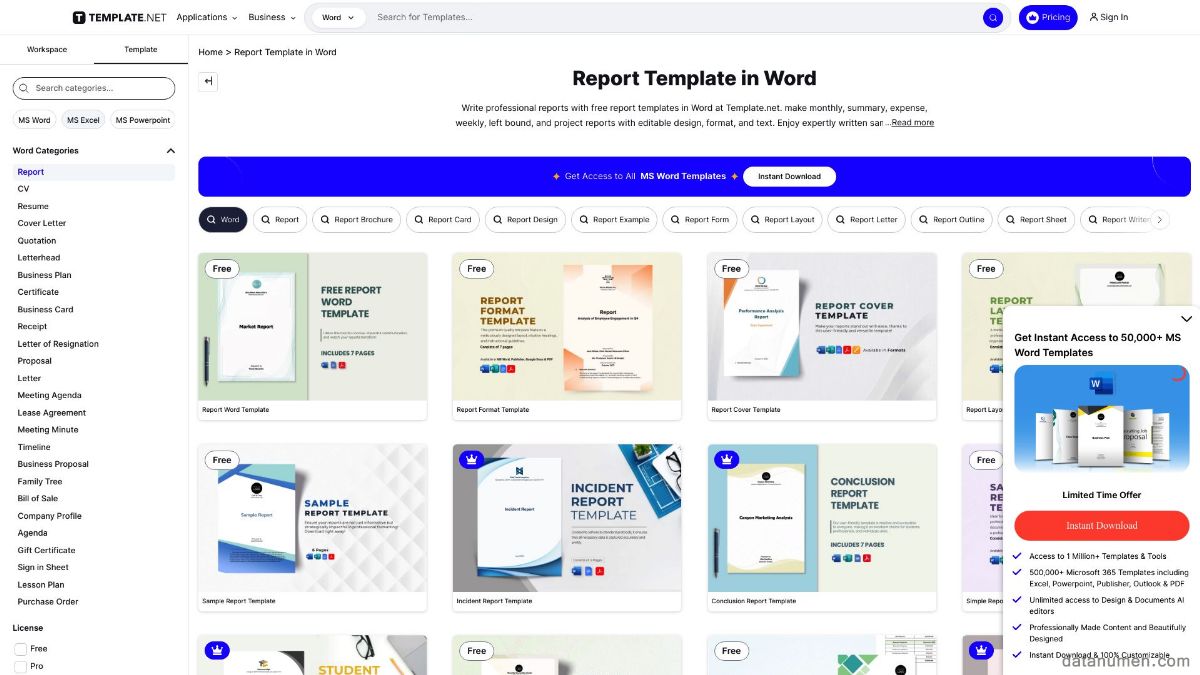
- Diverse Styles: Templates vary in style and design, ideal for users who want to present their reports with a creative twist.
- User-Friendly Environment: The platform has an intuitive layout, making it easy for users to navigate and find the most suitable template.
- Quality: Since templates are created by professionals, they maintain a high standard of quality and look very polished and professional.
- Cost: While some templates are available for free, access to a more extensive collection and advanced features requires payment or subscription.
- Overwhelming Choices: Although the array of designs is a strength, it can also be a downside for users who prefer a more straightforward selection process.
4. Office Templates Online Professional Report Templates For MS Word & Excel
Office Templates Online is a platform dedicated to providing high-quality report templates for Microsoft Word and Excel. It offers an enormous range of styles and designs, ranging from business reports to academic documents. Aimed at professionals in various fields, it streamlines the process of creating comprehensive reports.
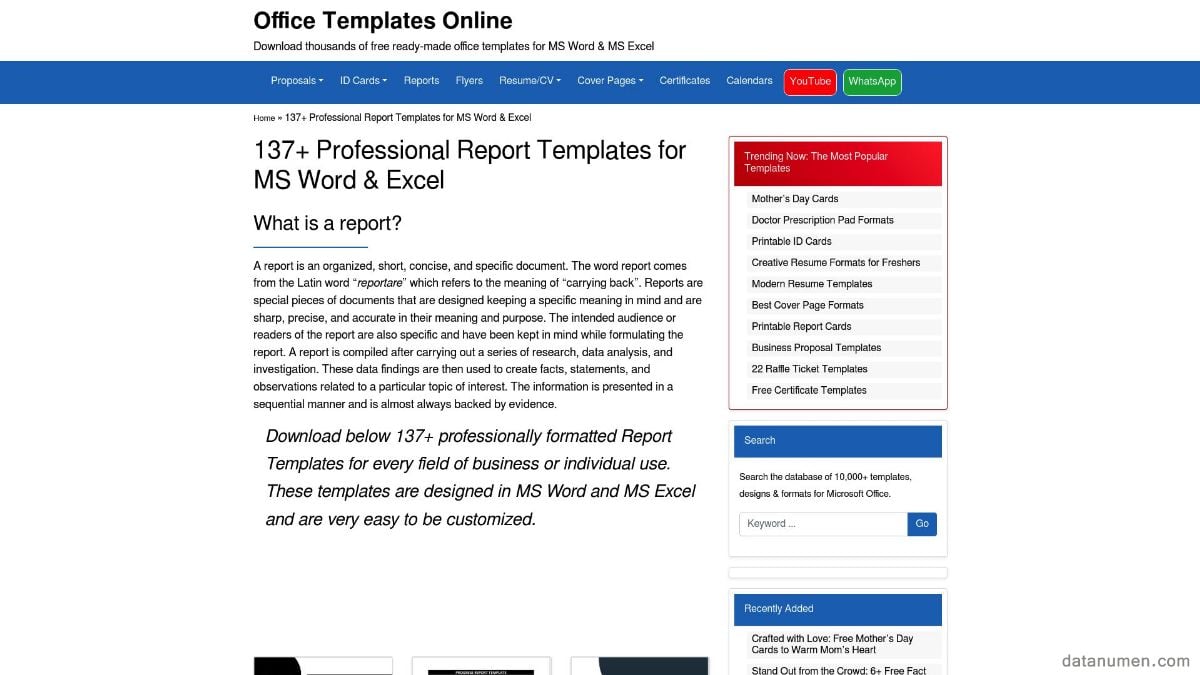
- Specialization: It specializes in report templates for Microsoft Word and Excel, hence it ensures full compatibility and smooth operation.
- Professional Designs: The designs offered are professional and suitable for formal settings, especially in the corporate world.
- Free Access: No payment is required to download and use the templates.
- Limited creativity: While the designs are professional, they can be simplistic and may not offer the same level of creativity as some other websites.
- Lack of variety: The template choices, though of high quality, may not offer as much variety as other platforms.
5. Word Templates For Free Download Report Templates
Word Templates for Free Download offers a selection of fully customizable report templates for Word. With basic functionality and clean designs, these templates are ideal for reports with straightforward requirements. This site presents users with an easy-to-use platform that doesn’t complicate the report-creating process.
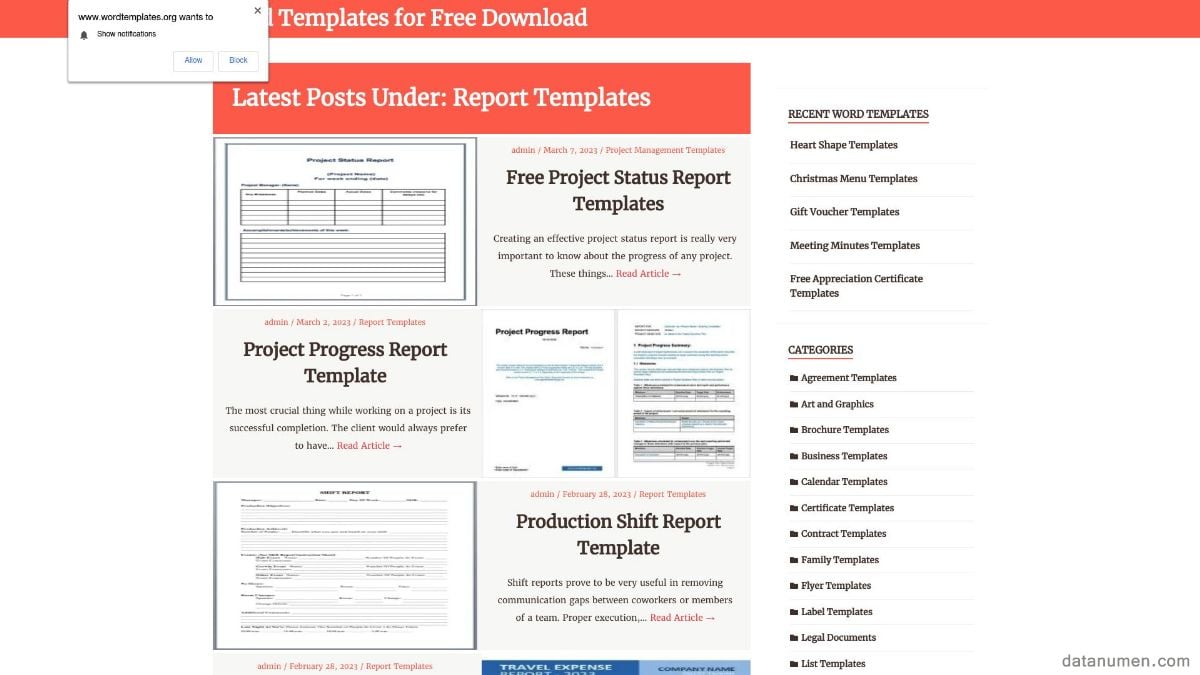
- Free resources: All the templates are completely free and can be downloaded without any fees or subscriptions.
- Simplicity: Templates have a simple and clean layout, allowing for easier customization and straightforward use.
- Focus on essentials: The website provides the essentials without extra fluff, ideal for users who need a basic but professional template.
- Limited designs: The variety and creativity of designs can be quite limited compared to other sites.
- Lack of advanced features: The templates may lack advanced features and complex design elements, which may not be suitable for users who need more elaborately designed reports.
6. Powered Template Report Word Templates
Powered Template is another resource-rich website providing an array of professionally designed Word report templates. Created by designers for business or personal use, their templates deliver a combination of great design with the functionality of MS Word.
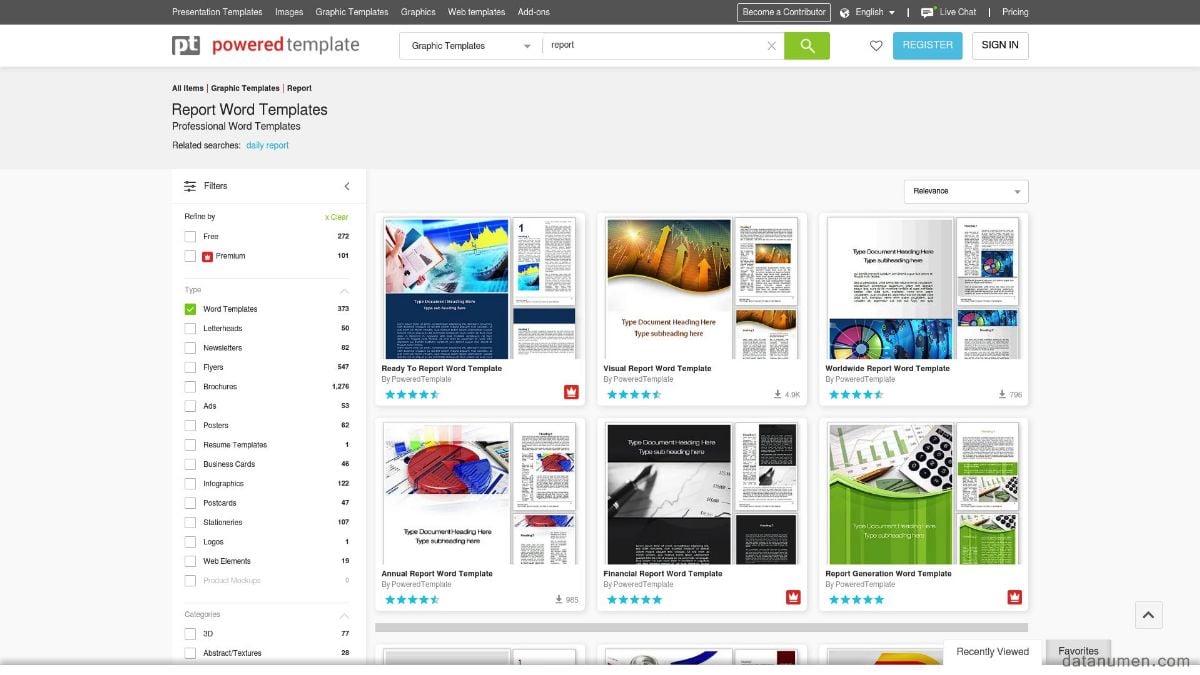
- Versatility: Their collection contains templates for various types of reports, accommodating a diverse range of needs.
- Professionally-designed: The templates are designed by professional designers, offering superior quality in terms of aesthetic appeal.
- Presentation-focused: Powered Template provides numerous infographic and data visualization tools, which can make reports more engaging and comprehensible.
- Cost: While some templates are available for free, many require payment. The price varies among the premium templates.
- Required Sign-up: Users need to sign-up to access some templates, which can be a barrier for those seeking quick access.
7. My Word Templates Report Template
My Word Templates provides a straightforward and user-friendly site for downloading various Word report templates. The site offers a solid array of designs and formats that cater to a wide spectrum of reporting needs, from academic to business-orientated reports or even for personal use.
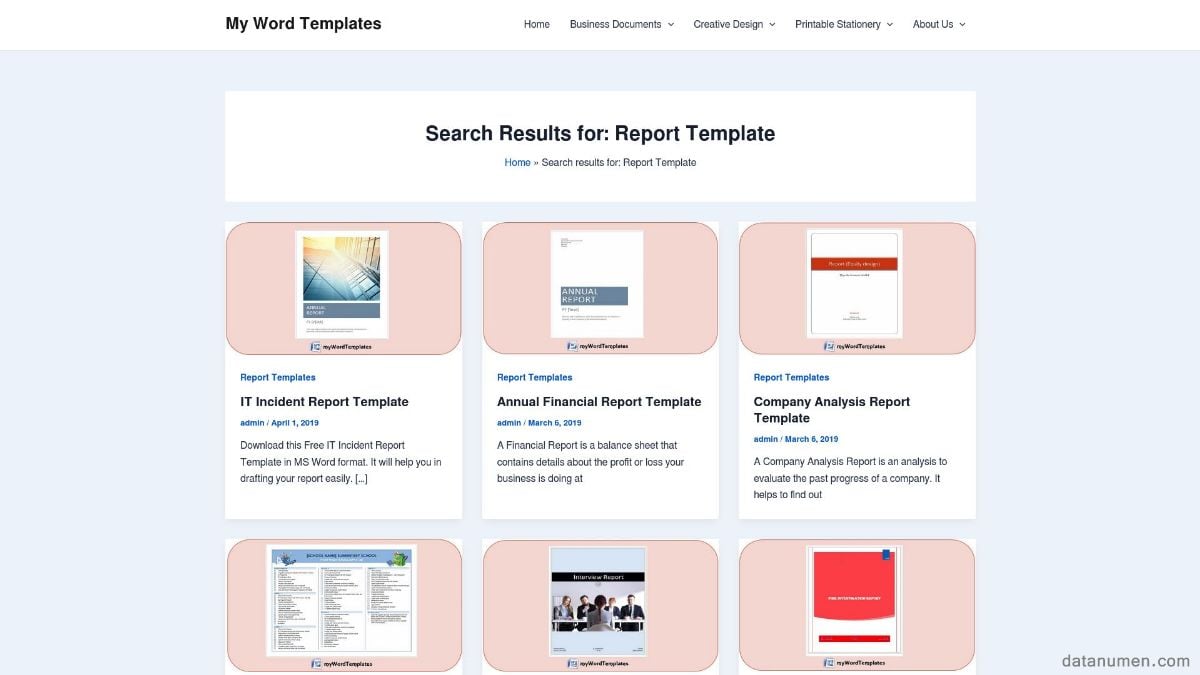
- Ease of use: With a simple interface , it takes just a few clicks to download and start using the templates.
- Free to use: All templates available on the site are free of charge, making it a budget-friendly option.
- Solid variety: The site offers a good assortment of templates to cater to different types of report needs.
- Limited designs: While there’s a good variety of templates, the design options might be limited if you’re looking for something very specific or unique.
- Basic features: The templates do not offer advanced perks like interactive charts or infographics.
8. Etsy LeafloveSpace Report Template
Etsy’s LeafloveSpace is a unique marketplace that offers designer-created Word report templates. It provides an off-the-beaten-path alternative for users searching for more creative and visually stunning templates.
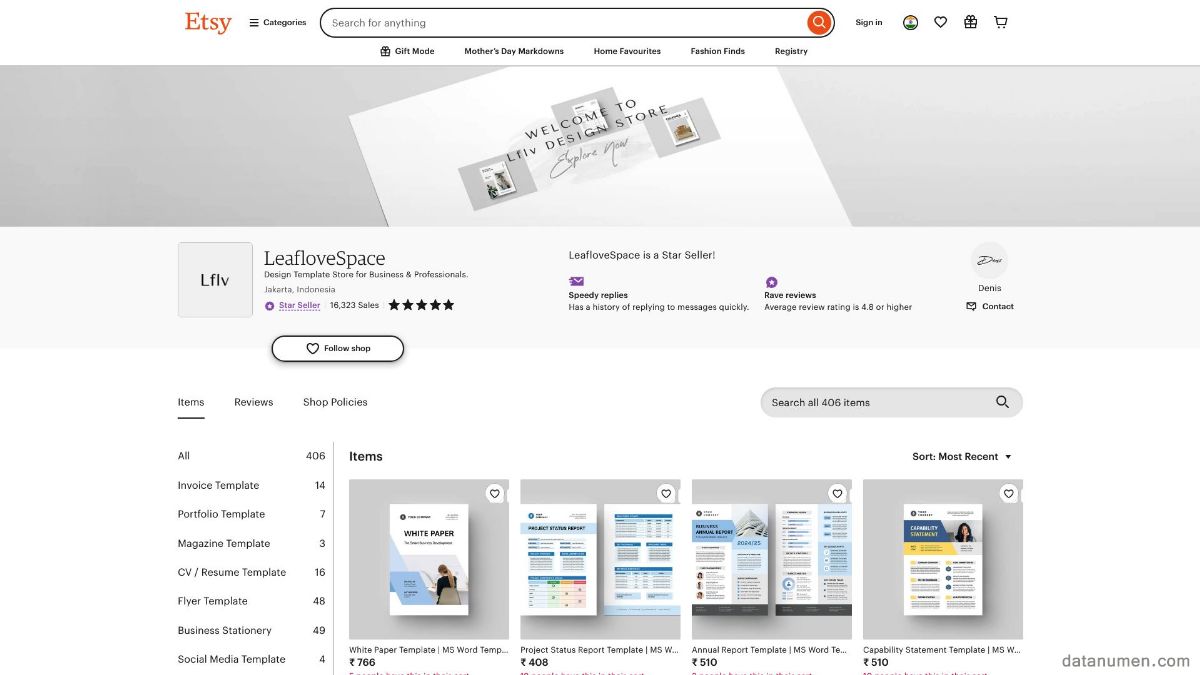
- Unique designs: Unlike more conventional sites, Etsy’s LeafloveSpace provides a plethora of original and creative templates.
- High quality: The templates are handcrafted by professional designers, ensuring a high-quality aesthetic finish.
- Positive customer feedback: The seller has a consistent record of positive customer reviews, indicating reliable service and product quality.
- Pricing: Users must purchase the templates, which may turn off individuals looking for free resources.
- Limited selection: The collection, while beautiful and unique, is far smaller than what more mainstream sites offer.
- Non-refundable: Due to the digital nature of the products, purchases are typically non-refundable, necessitating careful selection.
9. WPS Best Report Word Templates
WPS is known for its suite of office software, and among its array of services is a broad selection of Word report templates. With an easy-to-navigate site, WPS provides both well-designed templates and helpful resources for creating reports.
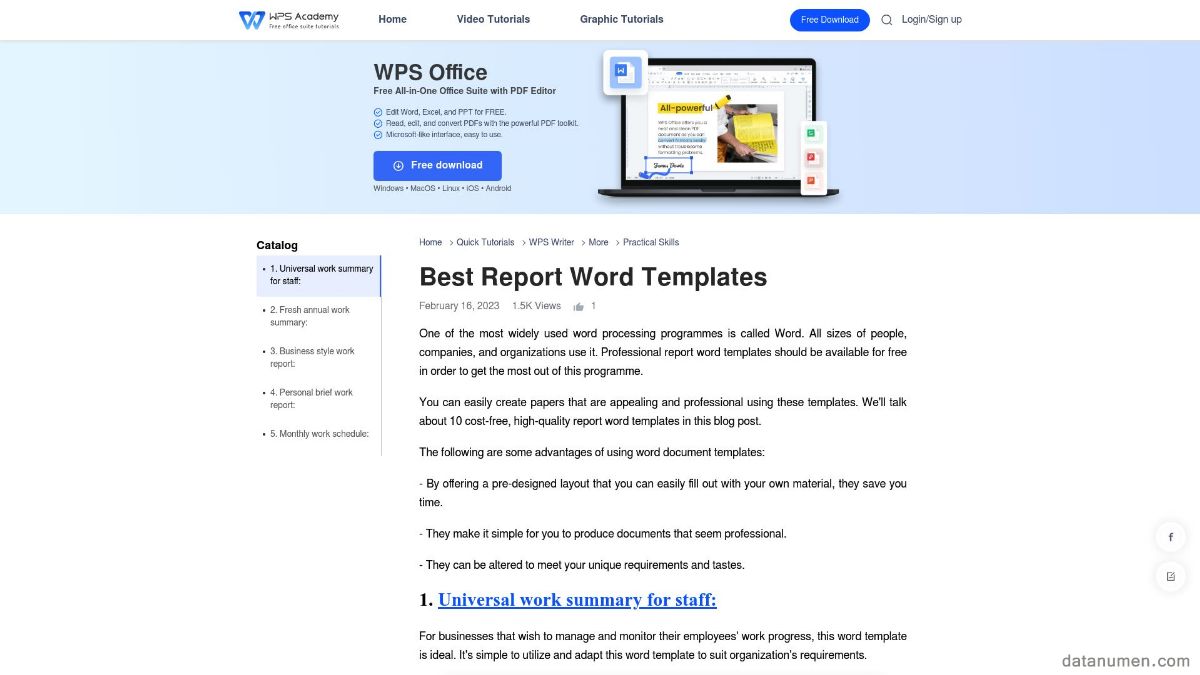
- High-quality designs: The templates provided by WPS are noted for their design quality and professional visual appeal.
- Additional resources: Alongside templates, WPS offers valuable how-to guides and tutorials, providing useful resources to help users create their reports.
- Wide Selection: With a vast array of templates from various fields and industries, users are likely to find a template that fits their needs.
- Compatibility: While these templates work well with WPS’s own software, there may be compatibility issues with other word processors.
- Cost: While many templates are available for free, some premium templates and features are behind a paywall.
10. HubSpot Monthly Report For Word, Excel, PDF, Google Docs, Google Slides
HubSpot, a leading platform in inbound marketing, sales, and customer service software, also offers an array of report templates. They are context-based and rich in content, targeting specific report requirements such as monthly analysis, project status, and more.
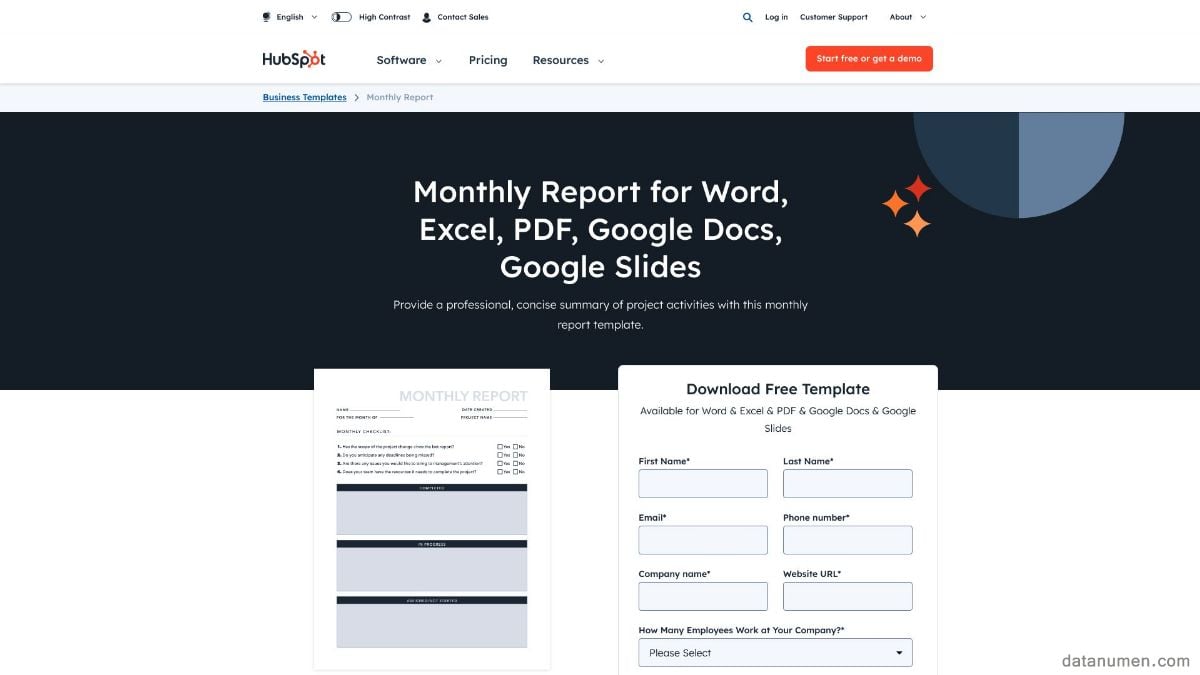
- Context Oriented: The templates provided by HubSpot are designed keeping specific use-cases in mind, ensuring they perfectly fit the purpose.
- Multiformat Support: The report templates support various formats like Word, Excel, PDF, and Google Docs, giving users the flexibility to choose according to their preference.
- Free Access: All templates by HubSpot can be accessed and downloaded for free.
- Registration Requirement: Users are required to register and provide contact information to download templates.
- Limited Styles: While the templates are content-rich, users looking for more creative designs may find the options slightly limited.
11. Smartsheet Project Status Report Templates
Smartsheet is an online work execution platform that allows teams to manage and automate collaborative work. Among its features is a suite of project status report templates. Smartsheet’s templates are specifically useful for project managers or teams needing to update stakeholders on their project’s progress.
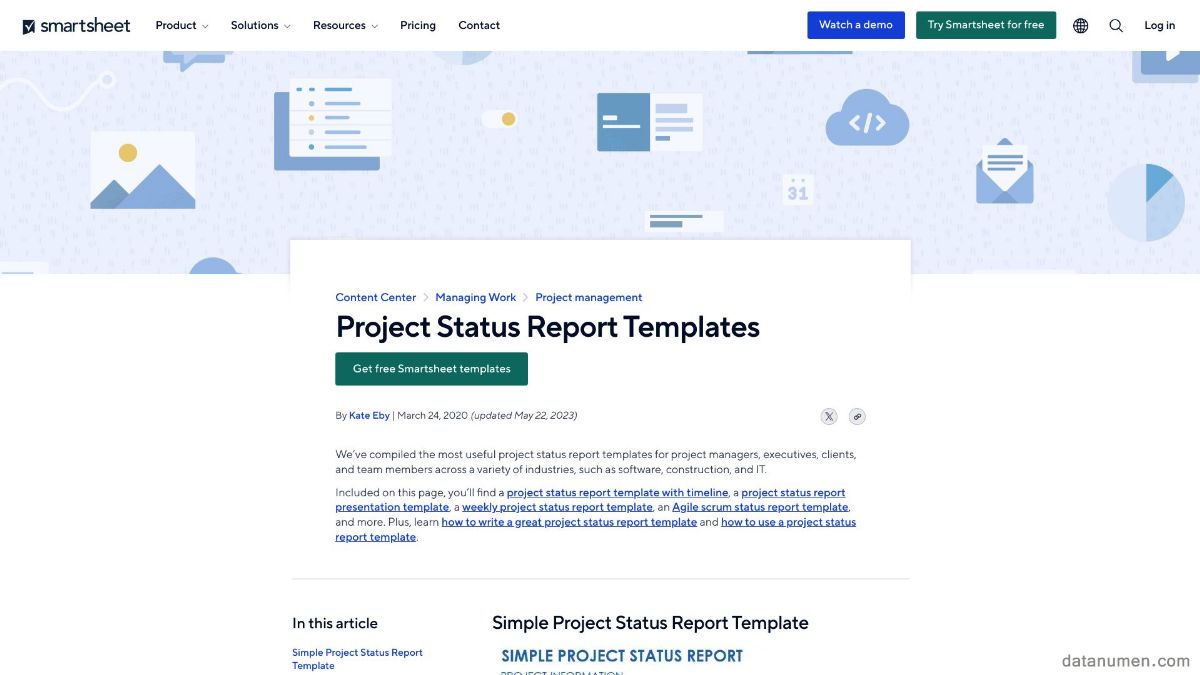
- Designed for Project Management: Templates are specifically designed for project status reporting, keeping stakeholders informed of critical project metrics.
- Integration: These templates can be fully integrated with Smartsheet’s project management software, allowing for real-time updates and excellent project visibility.
- Collaboration-friendly: The platform allows for seamless team collaboration and productivity management.
- Subscription based: To avail the full benefits of the templates, users need a Smartsheet subscription.
- Niche focus: While great for project management, they may not be suitable for other types of reports.
12. BestTemplates Report Templates
BestTemplates is an online resource site dedicated to providing excellent report templates for a variety of uses. It offers a vast catalog of professionally made designs that cater to diverse reporting requirements, from basic to the more complex.
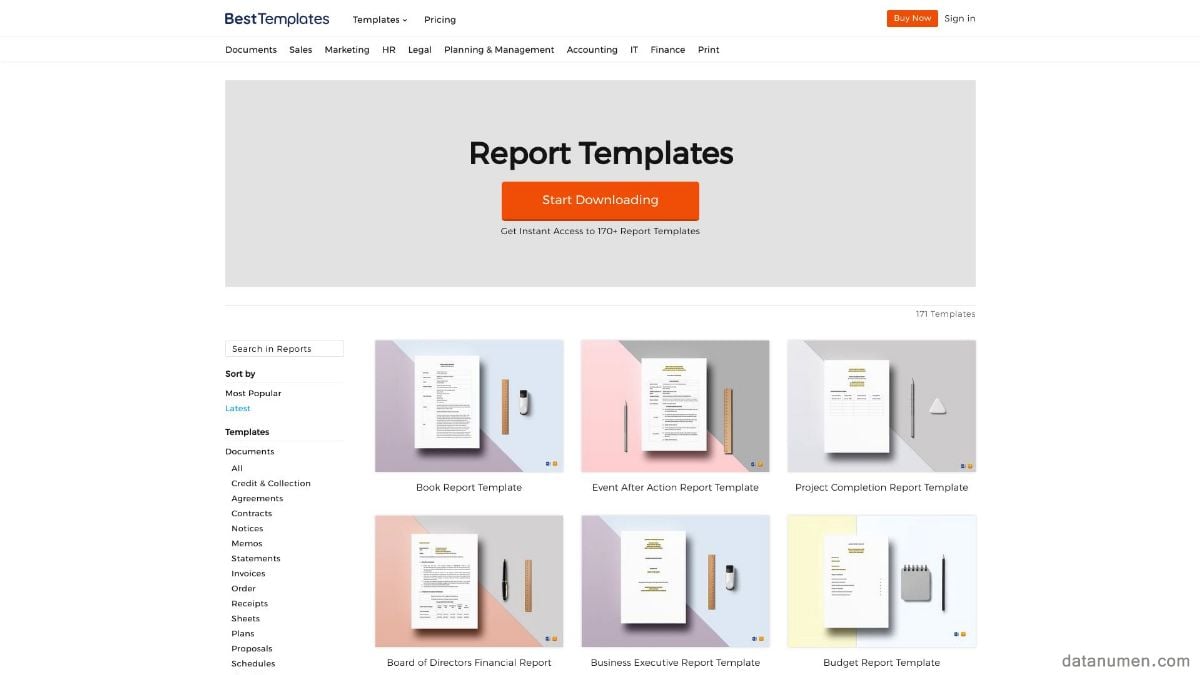
- Wide Range: The website provides a vast array of templates that cater to various industries and reporting requirements.
- Style and Flexibility: Templates are stylish, professional, and offer a high degree of customization to suit individual needs.
- High Quality: Templates are designed by professionals, ensuring a high standard of visual aesthetic and quality.
- Cost: Unlike many sites that offer free templates, BestTemplates is a premium service, and each template must be purchased individually.
- Complex designs: The high degree of customization could potentially be overwhelming to users who prefer simple and straightforward templates.
13. Summary
13.1 overall comparison table, 13.2 recommended template site based on various needs.
The ‘best’ site truly depends on the specific needs of the user. If cost is a critical factor, then the free resources provided by Microsoft Report Template, Office Templates Online or HubSpot might be the best fit. For users seeking creative designs, Etsy LeafloveSpace is recommended. Those needing detailed project report templates might find Smartsheet as the most suited. And, BestTemplates might cater best to users looking for a vast array of templates with a focus on quality and aesthetics.
14. Conclusion
14.1 final thoughts and takeaways for choosing an word report template site.
In conclusion, the selection of a Word report template site ultimately depends on the user’s needs, preferences, and budget. It’s essential to consider the quality and variety of templates, ease of use, compatibility with word processing software, and cost-effectiveness before making a decision.

While some sites offer free services, others charge a premium for their products. Free services, like Microsoft Report Templates and Office Templates Online are excellent for those on a budget, providing a solid starting point for creating professional-looking reports. On the other hand, premium sites, such as BestTemplates and Etsy LeafloveSpace, offer unique, high-quality designs for those willing to invest in their reports.
Remember, a carefully chosen and well-crafted template can significantly enhance the readers’ reception to your report. Thus, it’s worth investing the time and effort into finding the perfect template fitting your report’s purpose and audience.
Author Introduction:
Vera Chen is a data recovery expert in DataNumen, which provides a wide range of products, including a tool to fix Zip archive files .
Leave a Reply Cancel reply
Your email address will not be published. Required fields are marked *

IMAGES
VIDEO
COMMENTS
The cleanly formatted Google Doc can be downloaded as a fully editable MS Word Document (DOCX format), so you can use it as-is or convert it to LaTeX. Download The Research Paper Template. Download Grad Coach's comprehensive research paper template for free. Fully editable - includes detailed instructions and examples.
Education. 30 Editable Research Paper Templates (MLA Formats) February 23, 2021 6 Mins Read. A research paper template is a document that contains research questions, variable interpolation, thesis, methodology, and results evaluation. To create an effective research paper, make sure that everything you present comes from reliable sources.
Download this Word document, fill out the title page and get writing! Sample Paper APA 7th ed. Our APA sample paper shows you how to format the main parts of a basic research paper.
Student sample paper with annotations (PDF, 5MB) Professional sample paper with annotations (PDF, 2.7MB) We also offer these sample papers in Microsoft Word (.docx) format with the annotations as comments to the text. Student sample paper with annotations as comments (DOCX, 42KB) Professional sample paper with annotations as comments (DOCX, 103KB)
The formatting of a research paper is different depending on which style guide you're following. In addition to citations, APA, MLA, and Chicago provide format guidelines for things like font choices, page layout, format of headings and the format of the reference page. Scribbr offers free Microsoft Word templates for the most common formats.
Choose an APA template or MLA template, or other college-related template and open it in Word for the web to make it yours. You'll be on the Templates for Word page. In the list of categories, click College Tools. As you work on the paper, you'll probably want to rename it and edit the header with a running head of your own.
Throughout your paper, you need to apply the following APA format guidelines: Set page margins to 1 inch on all sides. Double-space all text, including headings. Indent the first line of every paragraph 0.5 inches. Use an accessible font (e.g., Times New Roman 12pt., Arial 11pt., or Georgia 11pt.).
How to write a research paper outline. Follow these steps to start your research paper outline: Decide on the subject of the paper. Write down all the ideas you want to include or discuss. Organize related ideas into sub-groups.
How to format your research paper. Go to Taylor & Francis Online and search for the title of your chosen journal using the search bar. Select the relevant journal and click on the instructions for authors tab. Read your target journal's instructions for authors, and find out about its formatting guidelines. Below are a list of Word templates ...
Fortunately, creating a template document can make this process much easier. To start setting up your research paper template: Open up an empty word processor document. Choose "Format" from the toolbar and select "Page Setup". You may now specify all desired parameters of your page size (A4 or Letter-sized) margins, gutter settings and ...
Body (section 2.11) Align the text to the left with a 1/2-inch left indent on the first line; Double-space; As long as there is no Abstract, at the top of the first page, type the title of the paper, centered, in bold, and in Sentence Case Capitalization; Usually, include sections like these: introduction, literature review or background, discussion, and conclusion -- but the specific ...
Research papers must be drafted in double column standard paper format (.doc/.docx). In case paper have technical equations and not possible to format in double column format, you can format in Single Column format. Download the IJSRP paper format (MS-Word) template and submit your research paper for review/final publishing.
Revised on July 23, 2023. We have designed several free templates to help you get started on a variety of academic topics. These range from formatting your thesis or dissertation to writing a table of contents or a list of abbreviations. We also have templates for various citation styles, including APA (6 and 7), MLA, and Chicago.
MLA Research Paper Template. MLA Research Paper Format Template is as follows: Page Setup. Use 8.5 x 11 inch white paper. Use a 12-point font, such as Times New Roman. Use double-spacing throughout the entire paper, including the title page and works cited page. Set the margins to 1 inch on all sides.
Your papers and reports will look as professional and well put together as they sound when you compose them using customizable Word templates.Whether you're writing a research paper for your university course or putting together a high priority presentation, designer-created templates are here to help you get started.First impressions are important, even for papers, and layout can make or ...
UCI Libraries maintains the following templates to assist in formatting your graduate manuscript. If you are formatting your manuscript in Microsoft Word, feel free to download and use the template. If you would like to see what your manuscript should look like, PDFs have been provided.
Word Template | Springer — International Publisher. Word Template. 573.35 kB (ZIP)
Make your research work successful and insightful by streamlining your research documentation and reporting procedures. Template.net is among the best platforms that offer premium research templates and samples in Word and other amazing formats. Research generally refers to a systematic activity of studying a certain subject.
Cite your MLA source. Start by applying these MLA format guidelines to your document: Use an easily readable font like 12 pt Times New Roman. Set 1 inch page margins. Use double line spacing. Include a ½" indent for new paragraphs. Include a four-line MLA heading on the first page. Center the paper's title.
Here's a short selection of 8 easy-to-edit white paper templates you can edit, share and download with Visme. View more templates below: Table of Contents ... In terms of functionality, think of the structure of a white paper more like a research paper and less of a report. The difference is that a report includes conclusions in the executive ...
This is where Word report template sites come into play. 1.1 Importance of Word Report Template Site. Word report template sites offer a variety of pre-designed report templates that can greatly reduce the time and effort involved in creating a report from scratch. These templates include different layouts, graphic elements, chart designs, and ...
IEEE provides guidelines for formatting your paper. These guidelines must be followed when you're submitting a manuscript for publication in an IEEE journal. Some of the key guidelines are: Formatting the text as two columns, in Times New Roman, 10 pt. Including a byline, an abstract, and a set of keywords at the start of the research paper.